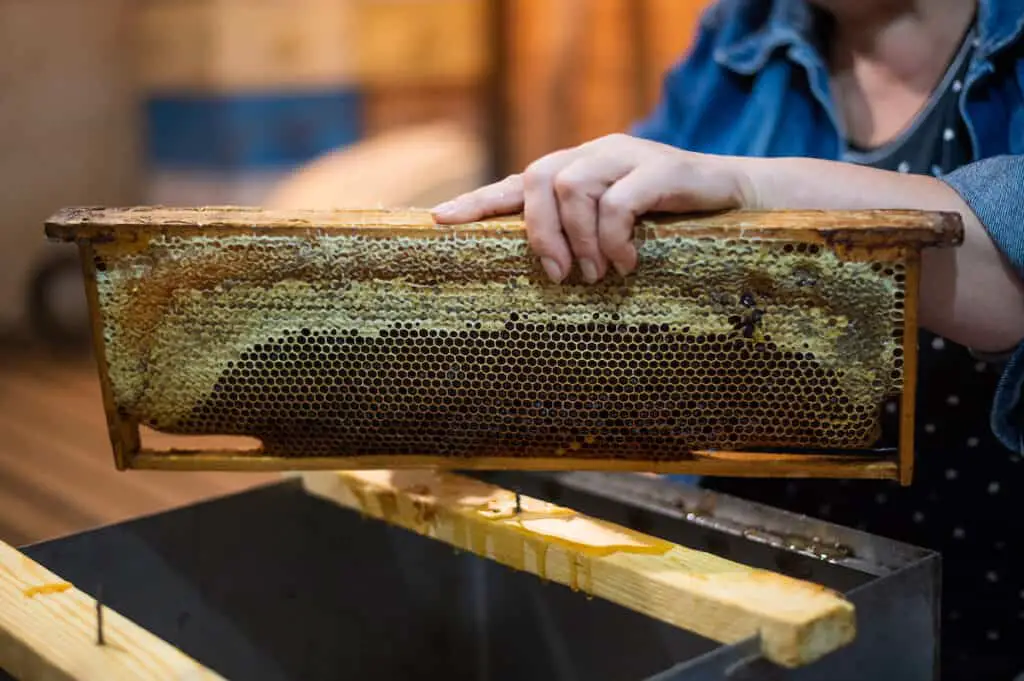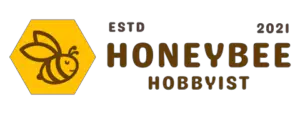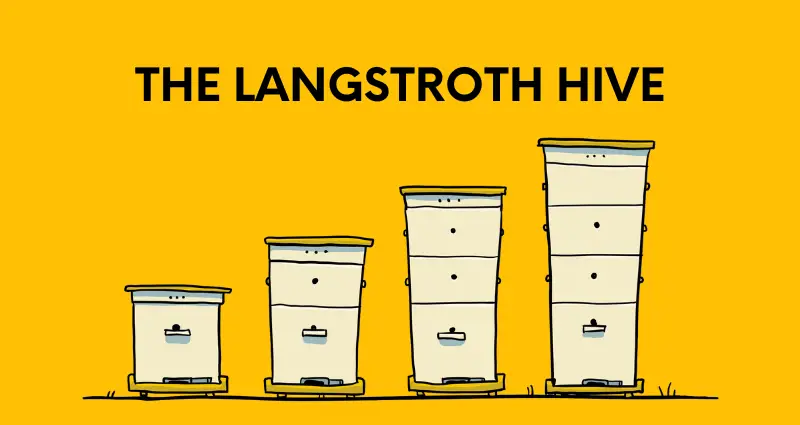The Langstroth beehive is the most common beehive in the United States. It is highly expandable, and each box holds eight to ten frames. High honey yields and easy expansion make it an excellent choice for commercial beekeeping.
History of the Langstroth Hive
Reverend Lorenzo Langstroth designed this hive in 1851. His most notable design concept was the need for a specific bee space. He found that the ideal bee space is between 6.4 and 9.5 millimeters. This space is large enough for the bees to fly between the combs but not so big that they will close the space with honeycomb or propolis.
This concept is now a crucial design component in most hives today. Its invention made inspections, maintenance, and harvesting much easier than it ever was.


Langstroth Hive Parts
- Outer Cover – There are two main top covers for a Langstroth hive. A metal telescoping cover is the most common. The cover extends over the corners of the top of the hive. It provides excellent weather protection, especially in a cold climate.
The other option is a migratory lid. A migratory lid is typically made from a piece of wood and lays flat on top of the hive. It is cheaper and provides less protection. - Optional Inner Cover – If your bees produce a lot of propolis, having an inner cover will make it easier to take off the outer cover. Additionally, if you live in an area with cold winters, an inner cover will also help to provide more insulation without condensation.
- Honey Supers – Eight or ten frames are set inside the honey supers, and the bees will produce honey here. Most beekeepers use medium or shallow supers.
- Optional Queen Excluder – If you want to ensure that your queen doesn’t lay eggs in the honey, you will want to use a screened queen excluder. This restricts her movement throughout the hive, keeping her in the lower boxes.
However, if you use an excluder, you must check it often. Drones can easily become stuck when traveling from the brood box to the hive body. - Deep Super – This deep box is commonly called the brood box. Here, you will find eggs, larvae, and pupae. Some cells also hold nectar, pollen, and honey to feed the young.
- Optional Entrance Reducer – This piece can help to protect a weak colony from being attacked or robbed. In a cold winter, it also helps to keep the hive insulated. It would be best if you did not use an entrance reducer in summer because it can cause the hive to become too warm.
- Bottom Board – This part of the hive is the foundation of everything. There are two types of bottom boards. A screened bottom board is ideal for hot climates and might also reduce varroa mites. A solid bottom board is ideal for cold temperatures. It keeps the hive warmer and reduces moisture.
- Hive Stand – Your hive should be approximately 18 inches off the ground. Not only does this height make it easier for the beekeeper, but it also protects the bees from ground predators and decreases humidity in the hive.

Standard Langstroth Hive Dimensions
The Langstroth boxes have the same width and length, but the depths differ. The shallow box (shallow super) has a depth of 5 7/8 inches. The medium box (medium super) has a depth of 6 5/8 inches. The deep box, usually used as the brood box, has a depth of 9 5/8.
Bees naturally build their combs downwards (as they do in top bar hives). The Langstroth forces them to build upwards. The Warre hive is a great option if you are more interested in natural beekeeping methods.
Varying Sizes of Langstroth Hives
Hive dimensions will vary depending on the manufacturer or type of material. For this reason, you will want to maintain both to ensure the hive boxes fit together.
Here are some alternative hive sizes to consider;
| Type | Depth | Frame length | Frame depth | Frame width |
|---|---|---|---|---|
| Jumbo/Dadant (Continental) body | 294 millimeters (11.6 in) | 19 inches (480 mm) | 285 millimeters (11.2 in) | 1+3⁄8 inches (35 mm) |
| Deep body | 9+9⁄16 inches (243 mm) | 19 inches (480 mm) | 9+1⁄8 inches (230 mm) | 1+3⁄8 inches (35 mm) |
| Medium (Illinois) body/super | 6+5⁄8 inches (170 mm) | 19 inches (480 mm) | 6+1⁄4 inches (160 mm) | 1+3⁄8 inches (35 mm) |
| Shallow Super | 5+3⁄4 inches (150 mm) | 19 inches (480 mm) | 5+3⁄8 inches (140 mm) | 1+3⁄8 inches (35 mm) |
| Comb super | 4+3⁄4 inches (120 mm) | 19 inches (480 mm) | 4+1⁄8 inches (100 mm) | 1+3⁄8 inches (35 mm) |
The next table showcases interior dimensions and volume for 5, 8, and 10 frame boxes in the shallow, medium, and deep body categories.
| Type | Depth | Interior length | Interior Width | Volume (Cubic Inches) | Volume (Liters) |
|---|---|---|---|---|---|
| 10 Frame Deep body | 9+5⁄8 inches (240 mm) | 18+3⁄8 inches (470 mm) | 14+3⁄4 inches (370 mm) | 2608.68 | 42.75 |
| 10 Frame Medium body/super | 6+5⁄8 inches (170 mm) | 18+3⁄8 inches (470 mm) | 14+3⁄4 inches (370 mm) | 1795.58 | 29.42 |
| 10 Frame Shallow Super | 5+11⁄16 inches (144 mm) | 18+3⁄8 inches (470 mm) | 14+3⁄4 inches (370 mm) | 1541.49 | 25.26 |
| 8 Frame Deep body | 9+5⁄8 inches (240 mm) | 18+3⁄8 inches (470 mm) | 12+1⁄4 inches (310 mm) | 2166.53 | 35.50 |
| 8 Frame Medium body/super | 6+5⁄8 inches (170 mm) | 18+3⁄8 inches (470 mm) | 12+1⁄4 inches (310 mm) | 1491.25 | 24.44 |
| 8 Frame Shallow Super | 5+11⁄16 inches (144 mm) | 18+3⁄8 inches (470 mm) | 12+1⁄4 inches (310 mm) | 1280.22 | 20.98 |
| 5 Frame Deep body | 9+5⁄8 inches (240 mm) | 18+3⁄8 inches (470 mm) | 7+3⁄4 inches (200 mm) | 1370.66 | 22.46 |
| 5 Frame Medium body/super | 6+5⁄8 inches (170 mm) | 18+3⁄8 inches (470 mm) | 7+3⁄4 inches (200 mm) | 943.44 | 15.46 |
| 5 Frame Shallow Super | 5+11⁄16 inches (144 mm) | 18+3⁄8 inches (470 mm) | 7+3⁄4 inches (200 mm) | 809.94 | 13.27 |
Foundation vs. Foundationless Frames
Most Langstroth frames use a foundation. It has a hexagonal design which guides the bees in terms of cell size and prevents cross comb. Some beekeepers dislike this frame style because the plastic foundation often contains chemicals and pesticides.
Foundationless frames are more natural. They allow the bees to create smaller cells, as they would in nature. Without foundation, bees tend to build combs faster. A few downsides to foundationless frames are the possibility of cross-comb and the over-production of drones.
How Much Honey Does the Langstroth Hive Produce?
You can expect approximately 40 to 70 pounds of surplus honey annually from an eight-frame box. The bees will likely make even more than this, but you can not harvest it all. Depending on your climate, you should leave between 40 and 90 pounds of honey for the bees to survive winter.
However, honey production can be increased or decreased by many factors. Some factors include the type of bees, the number of bees you have, the age of the hive, the weather, the available nectar, and nearby predators.
How to Extract Honey From a Langstroth Hive
You can harvest the honey in the fall in individual frames or boxes. You may need a tool to separate the top cover from the hive boxes.
Once you access the top super, remove a frame to ensure the honey is capped. If it isn’t, it is not ready. Continue removing the frames one by one, and use a bee brush to remove the bees from the frames gently. When using foundation frames, use a capping fork or knife to remove the capping from the cells.
Once the caps are removed, you can place the frames into an extractor and spin the honey out of the cells. Afterward, you will likely want to strain it and wait a few hours before bottling it. This allows the tiny fragments of beeswax, honeycomb, and air to rise to the surface.
If you are using foundationless frames, you can not use an extractor. You will use the crush and strain method.

Assembly and Bee Installation
Langstroth hives are generally sold unassembled. Some manufacturers sell assembled pieces, but some woodworking knowledge will be required. Overall, the process usually takes around two hours.
When nailing or screwing the pieces together, a layer of glue will help secure the pieces and make the hive body stronger overall. Always follow the manufacturer’s instructions closely.
When it comes time to introduce the bees, it is best to start with two deep hive boxes. As usual, put frames in the bottom hive but not the top. Place the queen cage on top of the frames and shake the bees into the top box. Once they have migrated and are eating away to free the queen, replace the top frames and continue.
Hive Maintenance
You should perform weekly checks during the first year of starting your Langstroth hive. It’s best to open the hive on a warm, sunny day when the foragers are out. Using smoke to calm the bees is at the discretion of the beekeeper.
As you inspect the brood frames, look for new eggs, capped brood with pollen nearby, new comb, and drone brood in 15% of the cells. An excess drone brood might signal that your queen has left the hive.
Putting the frames back in the same order you took them out is essential.
Once your hive is established, you can reduce your maintenance checks to about once a month. The hive should not be disturbed in the winter unless necessary. Opening it will disrupt the warmth the bees worked hard to create.
You should expand your hive in the spring and harvest full boxes of honey in the fall. A new super should be added when a box is 80% full. While supering is the most common way of adding bee boxes to a Langstroth, nadiring is also possible.
Additional Hive Elements To Consider
Hive Stand – Stands can create a stable base for the beehive, protect the hive from predators, maintain proper ventilation and temperature, and ensure the hive stays dry. Click to read our article on hive stands.
Cloake Board – A Cloake board is a special piece of hive equipment that is installed between two hives’ brood nests. A sliding wooden or metal panel inserted between the frames of a beehive will allow beekeepers to separate the bees from one another without lifting the entire box.
Feeders – A beekeeper uses a feeder to provide bees with sugary water during winter. Division boards are shaped like frames and are hung inside the hive in the same way as frames. Entrance feeders consist of small containers filled with sugar syrup at the hive’s entrance. Top feeders have a similar footprint to the main box and are placed on top but underneath the telescopic cover. Some beekeepers use inverted containers for feeding their bees. These contain small openings at the bottom of the box, where they place food. They’re usually placed directly on top of the frame or on top of one of the boxes’ inner covers.
Escape Board – An escape board is used when extracting or cleaning supers. It helps to remove most of the worker bee population from the super. It allows the bees to leave the supers into other areas but makes it difficult to get back into the supers.
Advantages
- Due to its popularity, it is easy to find replacement parts and full boxes.
- The hive produces high yields of honey.
- You do not need to worry about cross-combing if you use foundation frames.
- Because the boxes are added to the top, less heavy lifting is required.
- You can use a honey extractor.
- The Langstroth hive is more affordable than many other options.
- You can choose from multiple types of wood.
Disadvantages
- The inspections are very invasive.
- The environment is larger than a natural bee habitat.
- The honey bees are forced to build upwards.
- You need to have ample storage for extra equipment.
- Some heavy lifting is required. Full boxes of honey can weigh up to 80 pounds.
Many other beehive types include the Warre, Top Bar, and modern Flow Hive. Or click here to review a full list.

